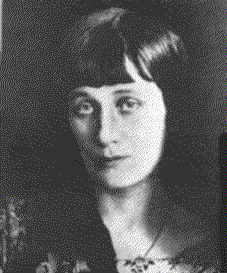
Anna Akhmatova (1889-1966)
"Requiem" Written about the Stalinist purges in 1930's Soviet Union in general, about her relationship with her victim son, Lev Gumilyov, in particular.
Issues in the work:
I. Importance of testimony/ Voice.
II. Juxtapose nature, human.
III. Collective voice versus individual.
IV. Distance, coping mechanism
A. It is not I.
B. I must learn to live again.
C. potential comfort of death. Of insanity
V. Primacy of Maternal.
A series of emotional states. Despair, bewilderment, anguish, grief, hopelessness, helplessness, resolution, camaraderie. More.
Akhmatova 1889-1966
The first passage points to the fact that these sufferers didn't even have the comfort of knowing they were not in their homeland. Instead, there where my people were.
The prose passage of "Instead of a Preface" seems the most chilling testament to the power of literature. And a poem like this belongs to the category of literature termed "testimony" or "bearing witness." Here what is brought out into the light isn't a way of thinking or feeling accessible to the author, but, primarily, experience. Belonging to this category is Holocaust literature, anti-apartheid literature, writing from China testifying to political oppression, and etc. Solzhenitsyn, who we didn't read today, becomes one of the most important figures on the 20th century with his testimony about the Soviet prison camps or "gulags," collected in The Gulag Archipelago. If you're interested in this kind of lit., perhaps a shortcut would be through A Day in the Life of Ivan Denisovitch.
But of all the writers bearing witness to the horrific events in the 20th C., few are able to do so with the artistry of Akhmatova who writes around events in a way that arouses the utmost compassion. So the instead of a preface writes the importance of remembering those who seem outside history and yet are victims of it. Those who feel that if only someone could hear their tale, some change might occur because of their suffering. That's all well and good, but here comes the stunning, devastating, chilling line "And something that looked like a smile passed fleetingly over what once had been her face." It may only be a line of such horrible suggestiveness that can bear up against the claim that follows "Mountains bow down to this grief."
1. Because poetry often works by contrast, juxtraposing seemingly incompatible images. So here, to suggest the bleakness of the "prison wives' existence, Akhmatova uses contrast.
Stanza 3 of the prologue suggests that Ak had to separate from herself in order to survive the grief and horror that her suffering has imposed upon her. Resounds with the "what once had been her face."
4. Part of the incomprehensibility comes perhaps from the gap between the "naughtiest girl of Pushkin's town" ("gay little sinner of Tsarskoye Selo") and the woman whose tempestuous tears burn through the New Year's ice.
7. And the irony of her list of "things to do" which become rather epochal moments in her life.
The motif of the alien wing returns in IX, this time the wing of madness. The devastation of her madness conjured up in the loss of self, loss of the things from her past, even of her memories.
The Epilogue
Where a kind of theme of the statue, the sculpture emerges. The first descriptions all take the animate face and harden it, with such terms as "bone, inscribes on cheeks the hard lines of cuneiform texts/ tarnished silver..
All suggesting not only rigidity where fluidity is expected, but also a kind of antiquity, as if the bone is from an archeological dig, etc. And this kind of suffering becomes ageless.
II. Where the concern turns to remembrance. Naming. But finally going overtly to the monument--of her. Here we have the obverse of the first passages, now the bronze sculpture, supposedly inanimate,, is now brought to life, by, of all things--tears.
Questions abut the text
1. The poem is inspired by a particular event in the life of Akhmatova, or, more specifically, by her relationship to a particular person. Who is that person?
2. The poem is dedicated to a particular group of people. Which group?
3. In your mind, what is the primary purpose of this poem? What does it achieve, that it sets out to achieve?
5. There are stanzas devoted to madness and death in the poem. What is the poet's attitude towards these two entities?
6. As a girl, Akhmatova, passing a park in which she knew her favorite writer Pushkin had strolled and worked, said, "someday they will put a statue of me there." At the end of "Requiem," she indicates that she'd like any statue of her to be in a particular locale. Where, and why?